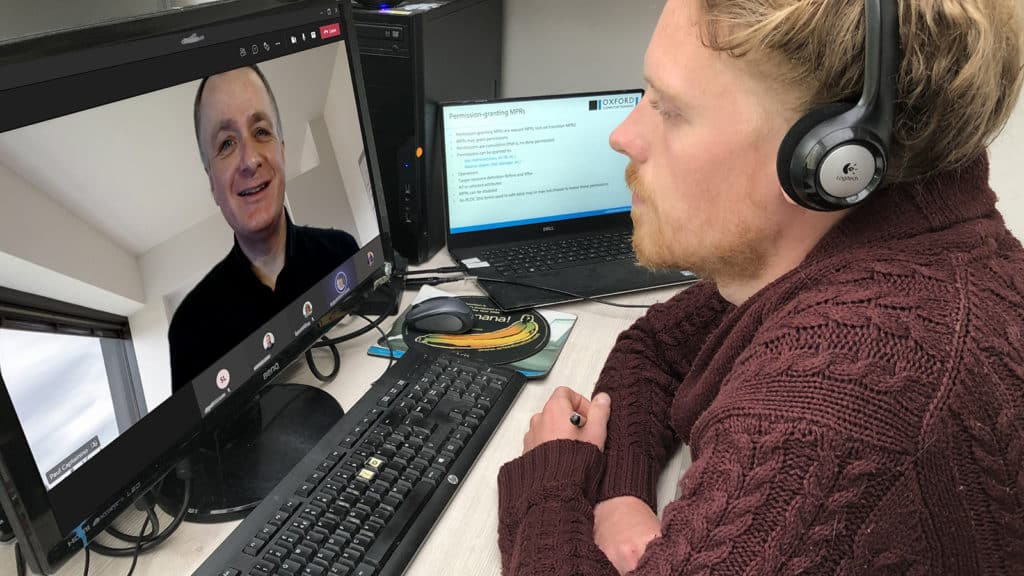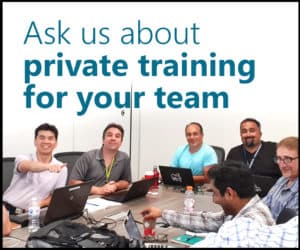Private MIM, Microsoft Entra ID, Microsoft Entra Connect and PAM training – an instructor’s perspective
Our very popular instructor Paul loves running our MIM, Microsoft Entra ID, Microsoft Entra Connect, and PAM training courses privately for IT teams. Why?

How long have you been a trainer? How many students have you taught?
Following 15 years as a consultant, I became an Identity Management trainer/consultant at Oxford Computer Training in 2010. Since then, I’ve taught our Microsoft Identity Manager (MIM), Microsoft Entra ID (formerly Azure AD), Microsoft Entra Connect (formerly Azure AD Connect) & PAM training courses to hundreds of IT professionals across the world, both in person and remotely via Teams.
Public courses or private courses – which are your favourite?
I enjoy public courses very much, and teaching students from different organizations is always very interesting. But I need to cover all the course content – module-by-module – on each public course, whereas private courses all have a different flavour.
What do you see as the benefits of private training?
- Organization-specific focus
There is much more freedom to go “off-piste” on private courses, to dig deeper into areas that are specific to the organization, and to spend time on the topics that are most relevant to a team’s environment.
- Opportunity to customize course content
Private courses also enable us to tailor the course content to the needs of an organization. For example, those without the MIM Portal often ask for a custom course that only covers MIM Sync topics. And because the MIM Portal elements are excluded, there is enough time to cover all the MIM Sync topics from both the Foundation and Advanced courses in a single 5-day private class.
Another popular option is to combine our Microsoft Entra Connect deep-dive course with our Microsoft Entra ID course. Taking each course separately takes 7 days but, as there is some overlap between them, I can cover all the material in 5 days.
- Open discussions
Discussions about the organization’s implementations and questions about improvements and future planning can be completely open on a private course. And any thorny issues students have been wrestling with, either individually or as a team, usually emerge early in the teaching week. As a trainer, this makes each private course particularly interesting for me.
- Team-building and collaboration
Typically there’s a lot more discussion between students on private courses and it’s very rewarding to see team members sharing ideas, and learning from each other – as well as from me!
 Can you give some examples?
Can you give some examples?
Our MIM Foundation public course covers workflows with examples of how they can be used to run PowerShell scripts, create user objects, or create and populate groups, but on a private course, I am often asked to elaborate and demonstrate how workflows can be built to handle the organization’s specific process requirements.
We can also delve into specific course elements, for example in one MIM Advanced private class, the organization didn’t want to use MIM reporting (which is covered in the course) so we used the time to review how the data could be fed into their system of choice, Splunk.
For one IT team taking a private MIM Expert course, we went beyond the course content to look at group synchronization. The training comprehensively covers syncing groups and members from the MIM Portal to AD – but this particular customer wanted to sync groups from AD to the MIM Portal, to manage membership of existing groups. The fact that it was a private training session meant we could spend time together setting this up in the classroom so that I could demonstrate the process in context rather than just discussing it.
Often, when students share issues or problems, we have a good idea of where the problem might lie, and we can provide pointers on how to troubleshoot it while teaching the relevant topic. This happened on a private Microsoft Entra ID training course – they had a problem syncing device information to the cloud when they had created the on-cloud device object by using Autopilot. The course covers the Microsoft Entra Connect sync engine, and how it applies its rules to different object types, so we were able to take the time to investigate the rules for devices and identify what might be missing in their implementation. We were able to access their system, and together we quickly identified and remediated the issue. It’s a great feeling when you see what you’re teaching immediately being put to good use by the students!
Via Teams or in-person – which is better?
I enjoy teaching on-site courses very much – and I’ve been lucky enough to have done so in many parts of the world. But teaching via Teams has many advantages and, since 2020 it’s been the norm for both our public and private courses.
We run courses for many multinational companies whose team members are widely spread geographically. For example, I remember a private course with participants from the US, UK, and India!
The technology is now so good that it’s possible to replicate many of the benefits of in-person training – including informal chat, brainstorming, etc – and teaching via Teams is also more cost-effective. There are no travel and accommodation expenses – either for me or for students. And, if more than five students attend, the cost per student is less than for a public course.
